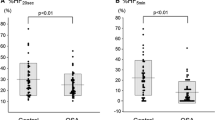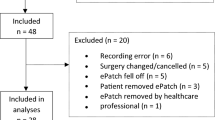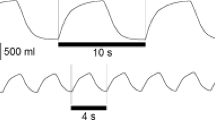Abstract
Opioids have an occasional but high-risk side effect of respiratory depression. The detection of critical respiratory depression usually occurs after the event. Earlier detection would be beneficial in preventing increased morbidity and mortality of 0.01 % patients receiving analgesic opioids. Airway patency during inspiration requires vagal modulation. Regulation of the cardiovascular and respiratory centres may be coupled with a central mechanism that is indirectly measurable with heart rate variability (HRV). While opioids tend to increase parasympathetic tone, a decrease in airway stability could be due to a decrease in respiratory parasympathetic activity. Sympathetic arousal generated by apneic events may separately be recognised with short-term HRV. This pilot observational study examined the dynamic sympathovagal changes during fentanyl–midazolam induced respiratory depression on 10 subjects scheduled for minor surgery. A selection of HRV indices, able to work over sub-minute periods on non-stationary signals, were applied including a range of less common indices. Three analyses tested the effects: post-fentanyl, preceding the first central depression, and preceding obstruction of the upper airway. Statistical significance was assessed with overlap of bootstrap percentile confidence intervals for the median. A decrease in total variability, Lomb Total using the Lomb–Scargle method, is a positive finding for short-term HRV use in this study. No significant change before critical respiratory events was observed in traditional, spectral power, respiratory or other indices. One index, PolVar20, indicated a burst of sympathetic activity preceding respiratory depression similar to sleep apnoea arousals that restore airway patency. Before its usefulness in early detection of airway tone can be determined, PolVar20 requires further work: a statistical method for highly skewed distributions, auto adjustment for baseline variability, and detecting a range of sympathetic responses to apnea.







Similar content being viewed by others
References
Ko S, Goldstein DH, VanDenKerkhof EG. Definitions of “respiratory depression” with intrathecal morphine postoperative analgesia: a review of the literature. Can J Anaesth. 2003;50(7):679–88.
Duarte LT, Fernandes Mdo C, Costa VV, Saraiva RA. The incidence of postoperative respiratory depression in patients undergoing intravenous or epidural analgesia with opioids. Rev Bras Anestesiol. 2009;59(4):409–20.
Fukuda K. Opioids. In: Miller RD, Eriksson LI, Fleisher LA, Wiener-Kronish JP, Young WL, editors. Miller’s anesthesia, vol 1, 7th ed. Philadelphia: Elsevier Churchill Livingstone; 2009. p. 769–824.
Kuna ST. Inhibition of inspiratory upper airway motoneuron activity by phasic volume feedback. J Appl Physiol. 1986;60(4):1373–9.
Malhotra A, White DP. Obstructive sleep apnoea. Lancet. 2002;360(9328):237–45. doi:10.1016/S0140-6736(02)09464-3.
Paton JF, Nolan PJ. Similarities in reflex control of laryngeal and cardiac vagal motor neurones. Respir Physiol. 2000;119(2–3):101–11.
Donchin Y, Feld JM, Porges SW. Respiratory sinus arrhythmia during recovery from isoflurane-nitrous oxide anesthesia. Anesth Analg. 1985;64(8):811–5.
Pomfrett CJ. Heart rate variability, BIS and ‘depth of anaesthesia’. Br J Anaesth. 1999;82(5):659–62.
Blues CM, Pomfrett CJ. Respiratory sinus arrhythmia and clinical signs of anaesthesia in children. Br J Anaesth. 1998;81(3):333–7.
Wang DY, Pomfrett CJ, Healy TE. Respiratory sinus arrhythmia: a new, objective sedation score. Br J Anaesth. 1993;71(3):354–8.
Vettorello M, Colombo R, De Grandis CE, Costantini E, Raimondi F. Effect of fentanyl on heart rate variability during spontaneous and paced breathing in healthy volunteers. Acta Anaesthesiol Scand. 2008;52(8):1064–70. doi:10.1111/j.1399-6576.2008.01713.x.
Mathru M, Esch O, Lang J, Herbert ME, Chaljub G, Goodacre B, vanSonnenberg E. Magnetic resonance imaging of the upper airway: effects of propofol anesthesia and nasal continuous positive airway pressure in humans. Anesthesiology. 1996;84(2):273–9.
Benumof JL. Obstructive sleep apnea in the adult obese patient: implications for airway management. J Clin Anesth. 2001;13(2):144–56.
Bradley TD, Floras JS. Obstructive sleep apnoea and its cardiovascular consequences. Lancet. 2009;373(9657):82–93. doi:10.1016/S0140-6736(08)61622-0.
Smith RP, Veale D, Pepin JL, Levy PA. Obstructive sleep apnoea and the autonomic nervous system. Sleep Med Rev. 1998;2(2):69–92.
Dingli K, Assimakopoulos T, Wraith PK, Fietze I, Witt C, Douglas NJ. Spectral oscillations of RR intervals in sleep apnoea/hypopnoea syndrome patients. Eur Respir J. 2003;22(6):943–50.
Bailey PL, Pace NL, Ashburn MA, Moll JW, East KA, Stanley TH. Frequent hypoxemia and apnea after sedation with midazolam and fentanyl. Anesthesiology. 1990;73(5):826–30.
Galletly DC, Westenberg AM, Robinson BJ, Corfiatis T. Effect of halothane, isoflurane and fentanyl on spectral components of heart rate variability. Br J Anaesth. 1994;72(2):177–80.
Komatsu T, Kimura T, Sanchala V, Shibutani K, Shimada Y. Effects of fentanyl–diazepam–pancuronium anesthesia on heart rate variability: a spectral analysis. J Cardiothorac Vasc Anesth. 1992;6(4):444–8.
Latson TW, McCarroll SM, Mirhej MA, Hyndman VA, Whitten CW, Lipton JM. Effects of three anesthetic induction techniques on heart rate variability. J Clin Anesth. 1992;4(4):265–76.
Riznyk L, Fijalkowska M, Przesmycki K. Effects of thiopental and propofol on heart rate variability during fentanyl-based induction of general anesthesia. Pharmacol Rep. 2005;57(1):128–34.
Schubert A, Palazzolo JA, Brum JM, Ribeiro MP, Tan M. Heart rate, heart rate variability, and blood pressure during perioperative stressor events in abdominal surgery. J Clin Anesth. 1997;9(1):52–60.
Smith AL, Owen H, Reynolds KJ. Heart rate variability indices for very short-term (30 beat) analysis. Part 1: survey and toolbox. J Clin Monit Comput. 2013;27(5):569–76. doi:10.1007/s10877-013-9471-4.
Smith AL, Owen H, Reynolds KJ. Heart rate variability indices for very short-term (30 beat) analysis. Part 2: validation. J Clin Monit Comput. 2013;27(5):577–85. doi:10.1007/s10877-013-9473-2.
Task Force of European Society of Cardiology. Heart rate variability: standards of measurement, physiological interpretation, and clinical use. Task Force of the European Society of Cardiology and the North American Society of Pacing and Electrophysiology. Eur Heart J. 1996;17(3):354–81.
Laguna P, Moody GB, Mark RG. Power spectral density of unevenly sampled data by least-square analysis: performance and application to heart rate signals. IEEE Trans Biomed Eng. 1998;45(6):698–715.
Moody GB. Spectral analysis of heart rate without resampling. Paper presented at the Computers in Cardiology. 1993. Proc., London, UK, Sep. 5–8.
Chang KL, Monahan KJ, Griffin MP, Lake D, Moorman JR. Comparison and clinical application of frequency domain methods in analysis of neonatal heart rate time series. Ann Biomed Eng. 2001;29(9):764–74.
Clifford GD. Signal processing methods for heart rate variability. Ph.D. thesis, Oxford University, Oxford. 2002.
Smith A-L. Using very short-term heart rate variability to monitor fentanyl-induced changes in the autonomic nervous system preceding respiratory depression. Ph.D. dissertation, Flinders University, Adelaide. 2011.
Hamilton RM, McKechnie PS, Macfarlane PW. Can cardiac vagal tone be estimated from the 10-second ECG? Int J Cardiol. 2004;95(1):109–15.
Thong T, Li K, McNames J, Aboy M, Goldstein B. Accuracy of ultra-short heart rate variability measures. Paper presented at the 25th annual international conference IEEE engineering in medicine and biology society, Cancun, Mexico, Sep 17–21. 2003.
de Bruyne MC, Kors JA, Hoes AW, Klootwijk P, Dekker JM, Hofman A, van Bemmel JH, Grobbee DE. Both decreased and increased heart rate variability on the standard 10-second electrocardiogram predict cardiac mortality in the elderly: the Rotterdam Study. Am J Epidemiol. 1999;150(12):1282–8.
Salahuddin L, Cho J, Jeong MG, Kim D. Ultra short term analysis of heart rate variability for monitoring mental stress in mobile settings. Paper presented at the 29th annual international conference IEEE engineering in medicine and biology society, Lyon, Aug 23–26. 2007.
Salahuddin L, Jeong MG, Kim D. Ultra short term analysis of heart rate variability using normal sinus rhythm and atrial fibrillation EGG data. Paper presented at the 9th international conference e-health networking, application and services, Taipei Jun. 19–22. 2007.
Suppappola S, Sun Y. A comparison of three QRS detection algorithms using the AHA ECG database. Paper presented at the proceedings of the annual international conference of the IEEE engineering in medicine and biology society, Orlando, FL. 1991.
Gonçalves H, Henriques-Coelho T, Bernardes J, Rocha AP, Nogueira A, Leite-Moreira A. Linear and nonlinear heart-rate analysis in a rat model of acute anoxia. Physiol Meas. 2008;29(9):1133–43. doi:10.1088/0967-3334/29/9/010.
Chernick MR. Bootstrap methods. 2nd ed. New York: Wiley Interscience; 2008. doi:10.1002/9780470192573.
Haukoos JS, Lewis RJ. Advanced statistics: bootstrapping confidence intervals for statistics with “difficult” distributions. Acad Emerg Med. 2005;12(4):360–5. doi:10.1197/j.aem.2004.11.018.
Efron B, Tibshirani R. An introduction to the bootstrap: monographs on statistics and applied probability, vol 57. New York: Chapman and Hall; 1993.
Carpenter J, Bithell J. Bootstrap confidence intervals: when, which, what? A practical guide for medical statisticians. Stat Med. 2000;19(9):1141–64. doi:10.1002/(SICI)1097-0258(20000515)19:9<1141:AID-SIM479>3.0.CO;2-F.
Cumming G. Inference by eye: reading the overlap of independent confidence intervals. Stat Med. 2009;28(2):205–20. doi:10.1002/sim.3471.
Wolfe R, Cumming G. Communicating the uncertainty in research findings: confidence intervals. J Sci Med Sport. 2004;7(2):138–43.
Keselman HJ, Cribbie R, Holland B. Controlling the rate of Type I error over a large set of statistical tests. Br J Math Stat Psychol. 2002;55(1):27–39.
Benjamini Y, Hochberg Y. Controlling the false discovery rate: a practical and powerful approach to multiple testing. J Roy Stat Soc Ser B. 1995;57(1):289–300. http://www.jstor.org/stable/2346101.
Sosnowski M, Petelenz T, Leski J. Return maps: a non-linear method for evaluation of respiratory sinus arrhythmia. Paper presented at the computers in cardiology 1994, Bethesda, MD, Sep 25–28. 1994.
Voss A, Kurths J, Kleiner HJ, Witt A, Wessel N, Saparin P, Osterziel KJ, Schurath R, Dietz R. The application of methods of non-linear dynamics for the improved and predictive recognition of patients threatened by sudden cardiac death. Cardiovasc Res. 1996;31(3):419–33.
Schirdewan A, Meyerfeldt U, Wessel N, Bondke HJ, Schreiber P, Sadowski R, Kamke W, Wiedemann M. Heart rate dynamics before the onset of ventricular tachyarrhythmias: results of the cardioverter defibrillator registry MARITA. J Am Coll Cardiol. 2004;43(5, Supplement 1):A125–A126.
Wessel N, Malberg H, Bauernschmitt R, Kurths J. Nonlinear methods of cardiovascular physics and their clinical applicability. Int J Bifurc Chaos. 2007;17(10):3325–71. doi:10.1142/S0218127407019093.
Freilich S, Goff EA, Malaweera AS, Twigg GL, Simonds AK, Mathias CJ, Morrell MJ. Sleep architecture and attenuated heart rate response to arousal from sleep in patients with autonomic failure. Sleep Med. 2010;11(1):87–92. doi:10.1016/j.sleep.2008.12.017.
Baguet JP, Barone-Rochette G, Pepin JL. Hypertension and obstructive sleep apnoea syndrome: current perspectives. J Hum Hypertens. 2009;23(7):431–43. doi:10.1038/jhh.2008.147.
Iturriaga R, Moya EA, Del Rio R. Cardiorespiratory alterations induced by intermittent hypoxia in a rat model of sleep apnea. Adv Exp Med Biol. 2011;669:271–4. doi:10.1007/978-1-4419-5692-7_55.
Cubuk R, Tasali N, Yilmazer S, Gokalp P, Celik L, Dagdeviren B, Guney S. Effect of an oral anxiolytic medication and heart rate variability on image quality of 64-slice MDCT coronary angiography. Radiol Med. 2011;116(1):47–55. doi:10.1007/s11547-010-0581-5.
Furutani Y, Shiigi T, Nakamura H, Nakamura Y, Ishizaki H, Uchiyama K, Harada M, Shimizu A, Matsuzaki M. Influence of the dead space induced by the face mask on the measure of heart rate variability (Japanese). J Cardiol. 1997;29(3):171–6.
Gole Y, Gargne O, Coulange M, Steinberg JG, Bouhaddi M, Jammes Y, Regnard J, Boussuges A. Hyperoxia-induced alterations in cardiovascular function and autonomic control during return to normoxic breathing. Eur J Appl Physiol. 2010;. doi:10.1007/s00421-010-1711-4.
Askanazi J, Silverberg P, Hyman A, Foster R, Yaremchuk M, Kinney JM. Effects of the mask and mouthpiece plus noseclip on spontaneous breathing pattern. Crit Care Med. 1978;6(3):143–6.
Eckberg DL. Human sinus arrhythmia as an index of vagal cardiac outflow. J Appl Physiol. 1983;54(4):961–6.
Lund VE, Kentala E, Scheinin H, Klossner J, Helenius H, Sariola-Heinonen K, Jalonen J. Heart rate variability in healthy volunteers during normobaric and hyperbaric hyperoxia. Acta Physiol Scand. 1999;167(1):29–35.
Bartels MN, Gonzalez JM, Kim W, De Meersman RE. Oxygen supplementation and cardiac-autonomic modulation in COPD. Chest. 2000;118(3):691–6.
Shibata S, Iwasaki K, Ogawa Y, Kato J, Ogawa S. Cardiovascular neuroregulation during acute exposure to 40, 70, and 100 % oxygen at sea level. Aviat Space Environ Med. 2005;76(12):1105–10.
Poyhonen M, Syvaoja S, Hartikainen J, Ruokonen E, Takala J. The effect of carbon dioxide, respiratory rate and tidal volume on human heart rate variability. Acta Anaesthesiol Scand. 2004;48(1):93–101.
Zickmann B, Hofmann HC, Pottkamper C, Knothe C, Boldt J, Hempelmann G. Changes in heart rate variability during induction of anesthesia with fentanyl and midazolam. J Cardiothorac Vasc Anesth. 1996;10(5):609–13.
Agelink MW, Majewski TB, Andrich J, Mueck-Weymann M. Short-term effects of intravenous benzodiazepines on autonomic neurocardiac regulation in humans: a comparison between midazolam, diazepam, and lorazepam. Crit Care Med. 2002;30(5):997–1006.
Komatsu T, Singh PK, Kimura T, Nishiwaki K, Bando K, Shimada Y. Differential effects of ketamine and midazolam on heart rate variability. Can J Anaesth. 1995;42(11):1003–9.
Michaloudis D, Kochiadakis G, Georgopoulou G, Fraidakis O, Chlouverakis G, Petrou A, Pollard BJ. The influence of premedication on heart rate variability. Anaesthesia. 1998;53(5):446–53.
Ristikankare M, Julkunen R, Heikkinen M, Laitinen T, Wang SX, Hartikainen J. Cardiac autonomic regulation during gastroscopy. Dig Liver Dis. 2009;41(9):648–52. doi:10.1016/j.dld.2009.01.008.
Win NN, Fukayama H, Kohase H, Umino M. The different effects of intravenous propofol and midazolam sedation on hemodynamic and heart rate variability. Anesth Analg. 2005;101(1):97–102.
Furutani M, Tanaka H, Agari I. Anxiety and heart rate variability before sleep indicate chronic stress in students. Percept Mot Skills. 2011;112(1):138–50.
Lee KC, Chao YH, Yiin JJ, Hsieh HY, Dai WJ, Chao YF. Evidence that music listening reduces preoperative patients’ anxiety. Biol Res Nurs. 2011;. doi:10.1177/1099800410396704.
Schachinger H, Muller BU, Strobel W, Drewe J, Ritz R. Effect of midazolam on transfer function between beat-to-beat arterial pressure and inter-beat interval length. Br J Anaesth. 2000;84(3):316–22.
Acknowledgments
Anaesthetist Dr. Cormac Fahy assisted with clinical studies. Statistical advice was provided by Mr. Pawel Skuza, Statistical Consultant, Flinders University. GE Healthcare (Chalfont St Giles, UK) provided S/5Collect software.
Conflict of interest
Anne-Louise Smith: Has neither financial disclosures nor conflicts of interests. Harry Owen: Has neither financial disclosures nor conflicts of interests. Karen Reynolds: Has neither financial disclosures nor conflicts of interests.
Author information
Authors and Affiliations
Corresponding author
Electronic supplementary material
Below is the link to the electronic supplementary material.
Rights and permissions
About this article
Cite this article
Smith, AL., Owen, H. & Reynolds, K.J. Can short-term heart rate variability be used to monitor fentanyl–midazolam induced changes in ANS preceding respiratory depression?. J Clin Monit Comput 29, 393–405 (2015). https://doi.org/10.1007/s10877-014-9617-z
Received:
Accepted:
Published:
Issue Date:
DOI: https://doi.org/10.1007/s10877-014-9617-z




